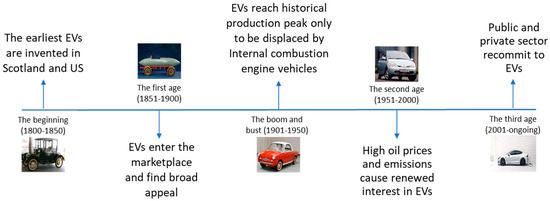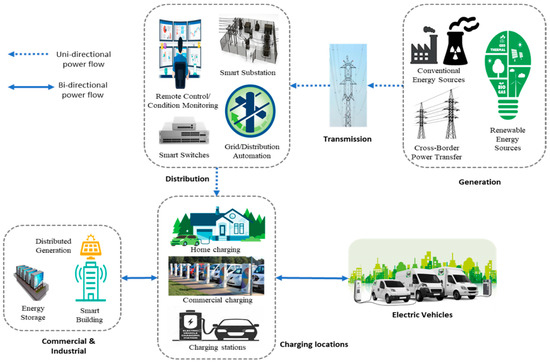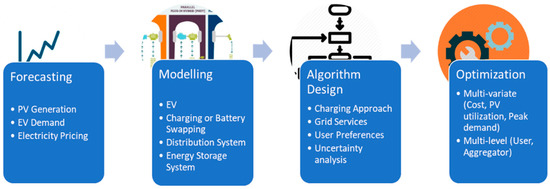Electric vehicles (EVs) are one of a prominent solution for the sustainability issues needing dire attention like global warming, depleting fossil fuel reserves, and greenhouse gas (GHG) emissions. Conversely, EVs are shown to emit higher emissions (measured from source to tailpipe) for the fossil fuel-based countries, which necessitates renewable energy sources (RES) for maximizing EV benefits. EVs can also act as a storage system, to mitigate the challenges associated with RES and to provide the grid with ancillary services, such as voltage regulation, frequency regulation, spinning reserve, etc. For extracting maximum benefits from EVs and minimizing the associated impact on the distribution network, modelling optimal integration of EVs in the network is required.
- plug-in electric vehicle
- energy management system
- renewable energy
- vehicle-to-grid
1. Introduction
The issues like global warming, depleting fossil fuel reserves, and greenhouse gas (GHG) emissions need dire attention for ensuring a sustainable future. Because the transportation sector is one of the largest contributors to the rising harmful emissions, the electrification of transportation is seen as a promising solution for this problem. Electric vehicle (EV) technology has existed for more than a century peaking commercially around 1900. However, due to the easy availability of fossil fuels, advancements in internal combustion (IC) technology, and simplicity in the use of IC engines, EVs were put on hold and limited to golf carts and delivery vehicles. Figure 1 shows the progression timeline of the EVs. The dependency on petroleum imports for transportation purposes is also reduced by electrification of transportation, thereby increasing energy security. However, the adoption rate of EVs remains slow owing to factors, such as high initial cost, battery degradation, inadequate charging infrastructure, range anxiety, etc. [1]. Various policies and incentives are made available by governments around the world to promote the uptake of EV and to prevent these barriers from realizing a complete shift to electrified transportation. As per the report “Global EV outlook” of the International Energy Agency, the total number of EVs are projected to reach 130 million by 2030 [2].

Figure 1. The evolution of electric vehicles (EVs).
However, high penetration of EVs also poses distribution network quality issues, particularly network congestion, three-phase voltage imbalance and off-nominal frequency problems. The EVs are a mobile single-phase load so they can be randomly plugged in at any one of three phases within distribution networks, leading to a scenario that electrical components in one particular phase, such as power supply cable, overhead line or transformer may be heavily loaded while the rest of two phases are not. The unbalanced three-phase loading may lead to a series of negative impact on power quality issue: Transformer failures, equipment loss-of-life, relay misfunction, etc. Moreover, as EVs are highly spatial and temporally uncertain, handling EVs as additional loads while maintaining the reliability and security of the grid is difficult. The coincidence of timing between EV home charging and residential load peaks leads to additional system peaks. Moreover, multiple EV chargers in a neighbourhood can introduce significant harmonics, thereby reducing power quality [3]. Therefore, the integration of substantial EV penetration in the distribution networks is a significant area of interest in the research and engineering community, especially optimally controlling EV charging to minimise the impact of the above-described issues.
Another significant contributor to harmful emissions is the power industry, particularly fossil fuel-based power generation. Renewable energy sources (RES), such as wind and solar are increasingly adopted to mitigate the power industry emissions. The variable nature of RES which depends on the weather, time, location, etc. creates voltage stability and reliability issues for the power grid requiring integration of Energy Storage System (ESS). Also, there may not be sufficient demand requirement during the period of high RES generation, which leads to the under-utilisation of average generated capacity. Using ESS with RES can result in its effective utilisation as ESS can store energy when demand is low and supply back when demand is high. Apart from using ESS, application of demand-side management techniques like load shifting, time of use pricing, and demand bidding can also solve the aforementioned problems associated with RES although the impact of these techniques is limited compared to ESS [4][5].
2. EV Interaction with the Distribution Network
Figure 2 shows a general representation of an EV connected to the electrical grid. The technology which allows the bidirectional flow of energy between EV and grid is known as vehicle-to-grid (V2G). It is achieved by the integration of Information and Communication Technologies (ICT) with the EV charging system. The modelling research of EV interaction with the distribution network has transitioned from unidirectional mode in the initial stage to bidirectional mode in the current stage [6][7].

Figure 2. EV integration with the electrical grid.
With the increasing level of EV penetration, the associated technical issues, e.g., system imbalance, decreased stability, and power quality, as well as increased system cost, are becoming more prominent, due to additional energy and power demand. The unidirectional approach, i.e., G2V mode, has been extensively studied in the literature in the form of topics like smart charging [8], safety [9], and control features [10]. The focus of these studies is on minimizing the charging cost [11] or minimizing the impact on the distribution system [12][13].
However, in the bidirectional mode, EV is not only the load for the grid, but also a distributed generation and storage. The initial idea was to use EV battery to store energy and send it back to the grid in peak period, known as peak load shaving [6]. Reference [14] presents a review of peak shaving strategies using demand-side management, energy storage systems, and electric vehicles. As an individual EV has a small battery capacity, a major challenge is the synchronisation of a large number of EVs charging/discharging operation required for them to be an effective storage system. Also, the limited uptake of EV did not quite make this idea of using EV in the bidirectional mode mainstream. Research later indicated that the application of bidirectional V2G in the ancillary market: Spinning reserve and voltage control is much more important than peak load reduction. Spinning reserve is the extra generation that can be made readily available, and it is paid for the availability along with the time it is called for deployment (compared to peak load shaving), which makes deployment of EV in ancillary service provision very economically favourable. Moreover, in terms of frequency of deployment, the voltage regulation is needed more than 300 times per day compared to the need for peak load shaving, which is only a few hundred hours per year [15].
Initially, V2G involved only energy transfer from EVs to the distribution system. However, with the advancement in technology, two new energy transfer modes (V2H and V2V) are added. Therefore, the bi-directional energy transfer from EV can now be classified into:
The control architectures for grid-connected EVs (with or without PVs) can be categorised into the following three methodologies:
-
Centralised scheduling;
-
The cost of PV has been dropping continuously and is currently less than $1/Wp [16].
-
PV is highly accessible, i.e., PV modules are generally installed on the building rooftops and carparks, close to EV locations.
-
PV modules do not require maintenance and are also noise-free.
-
EVs can store the surplus generated solar energy, thereby eliminating the need for battery systems
-
Vehicle-to-grid (V2G): Energy transfer from EV to the distribution network.
-
Vehicle-to-home/building (V2H/V2B): Energy transfer from EV to home/building.
-
Vehicle-to-vehicle (V2V): Energy transfer from one EV to another EV.
3. Modelling of Grid-Connected EV-PV System
The sustainability of EV depends on the source of charging. All forms of EVs, i.e., plug-in electric vehicle (PEV), hybrid electric vehicle (HEV), or plug-in hybrid electric vehicle (PHEV), have lower emissions if the energy supplied for charging is based on clean fuel, such as renewable sources. However, contrary to popular belief if the EVs are charged from fossil fuel or gas-based generation, the emissions are significant and not zero. The RES, i.e., PV, wind, tidal, geothermal, or hydro, are excellent options to power electric vehicles. Moreover, the following reasons make PV an admirable source to charge the EVs:
Figure 3 shows a general framework for designing a smart charging system for integrating EV-PV system into the grid.

Figure 3. A general outline for modelling a grid-connected EV-PV charging system.
Decentralised scheduling;
-
Price-varying scheduling.
4. EV Smart Charging Using PV and Grid
Multiple studies have explored the advantages of a PV based EV charging system. Reference [19] demonstrates the advantage of using PV to charge the EV and show that it allows for greater penetration of both PV and EV. EVs can also mitigate the negative effects of excess PV generation [20]. In Reference [24], the authors use centralized optimization software, based on a linear programming method, to manage the power exchange between EV sources and the grid. The system manages charging priorities by verifying photovoltaic energy, energy storage and connected electric vehicles to mitigate grid load peaks. Reference [21] presents a case study of Columbus, USA, in which it is demonstrated that charging EV from the PV is more economical and produces less CO2 footprint than charging EV from the grid. A case study presented in Reference [22] compares charging of EVs through the modes: Only grid, only PV with battery storage and grid integrated PV and finds that the grid integrated PV performs better economically compared to the other two systems. In Reference [23], the authors discuss the application of PV energy and EV as an energy storage system to mitigate the peak loading in the grid. These studies demonstrate the advantages of PV based EV charging over grid EV charging. There is a vast amount of literature on different charging algorithms or achieving different economic, technical, or social objectives related to PV based EV charging[24].
5. Conclusions
Electric vehicles and renewable energy-based generation are a promising solution to rising GHG emissions. Further, EVs can act as a dynamic energy storage system through the technology of V2G, thereby, facilitating RES integration in the smart grid. Also, well to wheel emissions from EVs depend upon the charging source. Therefore, RES based EV charging is desired for the overall reduction in emissions and getting the best of both technologies. Thus, this research area is quite popular and needs further exploration for worldwide implementation.
References
- Asaad, M.; Shrivastava, P.; Alam, M.S.; Rafat, Y.; Pillai, R.K. Viability of xEVs in India: A public opinion survey. In Lecture Notes in Electrical Engineering; Springer, Singapore, 2018; Volume 487, pp. 165–178; ISBN 9789811082481.
- Bunsen, T.; Cazzola, P.; Gorner, M.; Paoli, L.; Scheffer, S.; Schuitmaker, R.; Tattini, J.; Teter, J. Global EV Outlook 2018: Towards Cross-Modal Electrification; International Energy Agency, Paris, France, 2018.
- Monteiro, V.; Gonçalves, H.; Afonso, J.L. Impact of Electric Vehicles on power quality in a Smart Grid context. In Proceedings of the 11th International Conference on Electrical Power Quality and Utilisation, Lisbon, Portugal, 17–19 October 2011; pp. 1–6.
- Jordehi, A.R. Optimisation of demand response in electric power systems, a review. Renew. Sustain. Energy Rev. 2019, 103, 308–319, doi:10.1016/j.rser.2018.12.054.
- Strbac, G. Demand side management: Benefits and challenges. Energy Policy 2008, 36, 4419–4426, doi:10.1016/j.enpol.2008.09.030.
- Kempton, W.; Letendre, S.E. Electric vehicles as a new power source for electric utilities. Transp. Res. Part D Transp. Environ. 1997, 2, 157–175, doi:10.1016/s1361-9209(97)00001-1.
- Paşaoğlu, G.; Fiorello, D.; Martino, A.; Zani, L.; Zubaryeva, A.; Thiel, C. Travel patterns and the potential use of electric cars—Results from a direct survey in six European countries. Technol. Forecast. Soc. Chang. 2014, 87, 51–59, doi:10.1016/j.techfore.2013.10.018.
- Su, J.; Lie, T.; Zamora, R. Modelling of large-scale electric vehicles charging demand: A New Zealand case study. Electr. Power Syst. Res. 2019, 167, 171–182, doi:10.1016/j.epsr.2018.10.030.
- Chung, C.-Y.; Youn, E.; Chynoweth, J.S.; Qiu, C.; Chu, C.-C.; Gadh, R. Safety design for smart Electric Vehicle charging with current and multiplexing control. In Proceedings of the 2013 IEEE International Conference on Smart Grid Communications (SmartGridComm), Vancouver, Canada, 21–24 October 2013; pp. 540–545.
- Zheng, Y.; Niu, S.; Shang, Y.; Shao, Z.; Jian, L. Integrating plug-in electric vehicles into power grids: A comprehensive review on power interaction mode, scheduling methodology and mathematical foundation. Renew. Sustain. Energy Rev. 2019, 112, 424–439, doi:10.1016/j.rser.2019.05.059.
- He, Y.; Venkatesh, B.; Guan, L. Optimal scheduling for charging and discharging of electric vehicles. IEEE Trans. Smart Grid 2012, 3, 1095–1105, doi:10.1109/TSG.2011.2173507.
- Ahn, C.; Li, C.-T.; Peng, H. Optimal decentralized charging control algorithm for electrified vehicles connected to smart grid. J. Power Sources 2011, 196, 10369–10379, doi:10.1016/j.jpowsour.2011.06.093.
- Hu, J.; You, S.; Lind, M.; Østergaard, J. Coordinated charging of electric vehicles for congestion prevention in the distribution grid. IEEE Trans. Smart Grid 2013, 5, 703–711, doi:10.1109/TSG.2013.2279007.
- Uddin, M.; Romlie, M.; Abdullah, M.F.; Halim, S.A.; Abu Bakar, A.H.; Kwang, T.C. A review on peak load shaving strategies. Renew. Sustain. Energy Rev. 2018, 82, 3323–3332, doi:10.1016/j.rser.2017.10.056.
- Letendre, S.E.; Kempton, W. The V2G concept: A new model for power? Public Util. Fortn. 2002, 140, 16–26.
- Feldman, D.; Barbose, G.; Margolis, R.; Wiser, R.; Darghouth, N.; Goodrich, A. Photovoltaic (PV) Pricing Trends: Historical, Recent, and Near-Term Projections; National Renewable Energy Laboratory, Golden, United States, 2012.
- Goli, P.; Shireen, W. PV powered smart charging station for PHEVs. Renew. Energy 2014, 66, 280–287, doi:10.1016/j.renene.2013.11.066.
- Carli, G.; Williamson, S.S. Technical considerations on power conversion for electric and plug-in hybrid electric vehicle battery charging in photovoltaic installations. IEEE Trans. Power Electron. 2013, 28, 5784–5792, doi:10.1109/TPEL.2013.2260562.
- Denholm, P.; Kuss, M.; Margolis, R.M. Co-benefits of large scale plug-in hybrid electric vehicle and solar PV deployment. J. Power Sources 2013, 236, 350–356, doi:10.1016/j.jpowsour.2012.10.007.
- Nunes, P.; Farias, T.L.; Brito, M.C. Day charging electric vehicles with excess solar electricity for a sustainable energy system. Energy 2015, 80, 263–274, doi:10.1016/j.energy.2014.11.069.
- Tulpule, P.; Marano, V.; Yurkovich, S.; Rizzoni, G. Economic and environmental impacts of a PV powered workplace parking garage charging station. Appl. Energy 2013, 108, 323–332, doi:10.1016/j.apenergy.2013.02.068.
- Sarkar, J.; Bhattacharyya, S. Operating characteristics of transcritical CO2 heat pump for simultaneous water cooling and heating. Arch. Thermodyn. 2011, 33, 23–40, doi:10.2478/v10173-012-0026-8.
- Kempton, W.; Tomić, J. Vehicle-to-grid power implementation: From stabilizing the grid to supporting large-scale renewable energy. J. Power Sources 2005, 144, 280–294, doi:10.1016/j.jpowsour.2004.12.022.
- Luigi Rubino; Guido Rubino; Raffaele Esempio; Linear Programming-Based Power Management for a Multi-Feeder Ultra-Fast DC Charging Station. Energies 2023, 16, 1213.
